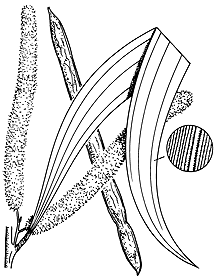Common name: Blake's wattle, Wollomombi wattle
Acacia blakei Pedley APNI* Synonyms: Racosperma blakei (Pedley) Pedley APNI*

Description: Erect or spreading tree or shrub 2–13 m high; bark fissured, often stringy-like, grey or blackish; branchlets angled towards apices, otherwise terete, often scurfy.
Phyllodes dimorphic, straight to falcate, mostly 5–17 cm long and 7–20 mm wide, longitudinal veins numerous, closely spaced, non-anastomosing, 3 slightly more prominent, (3-) 4–8 (-11) veins per mm, apex acute; 1 small gland at base; pulvinus 2–5 mm long.
Inflorescences 1–3 in axil of phyllodes or on an axillary axis to 20 mm long; peduncles 1–5 mm long, sometimes sparsely hairy or mealy; heads cylindrical, 2–6 cm long, yellow to pale yellow or cream-coloured.
Pods straight to curved, ± flat except over seeds, barely or slightly constricted between seeds, 3–10 cm long, 2–4 mm wide, firmly papery to thinly leathery, smooth or longitudinally wrinkled, glabrous or sparsely hairy with small hairs near the base and apex of mature pods; seeds longitudinal; funicle folded and enlarging into a fleshy aril.
Flowering: August–November.
Distribution and occurrence: mainly occurs in northern coastal and tableland regions. Grows in dry sclerophyll forest and woodland.
NSW subdivisions: NC, CC, NT, CT, CWS
Other Australian states: Qld
Named after Stanley T. Blake (1911-1973), former botanist with the Queensland Herbarium. The differences between, and status of, the subspecies require further investigation. Phyllode shape is variable, especially in subsp. diphylla.
Text by P.G. Kodela (last updated May 2012)
Taxon concept: P.G. Kodela & G.J. Harden, Flora of NSW Vol. 2 (2002)
| | Key to the subspecies | |
| 1 | Phyllodes of immature plants narrow-elliptic to very narrow-elliptic, often curved, to 22 mm wide; calyx with glabrous or hairy tube and often with minute red-brown papillae on lobes. | subsp. blakei |
| Phyllodes of immature plants elliptic to narrow-elliptic (markedly different in shape to mature phyllodes but also with intermediate forms), straight, to 40 mm wide; calyx usually densely white-hairy. | subsp. diphylla |
APNI* Provides a link to the Australian Plant Name Index (hosted by the Australian National Botanic Gardens) for comprehensive bibliographic data
***The AVH map option provides a detailed interactive Australia wide distribution map drawn from collections held by all major Australian herbaria participating in the Australian Virtual Herbarium project.
|


